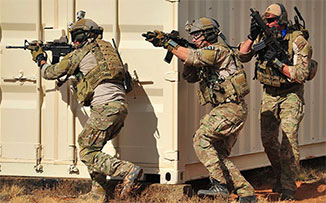AFSOC - Forward Area Refueling Point (FARP)

A CV-22 Osprey takes on JP-8 aviation fuel from a MC-130J Commando II aircraft with the 67th Special Operations Squadron.
The MC-130 is stationed at a forward area refueling point, or FARP.
In a typical FARP, a tanker parks up and supplies fuel to helicopters, CV-22 Ospreys and fixed wing aircraft via hoses connected to its on-board tanks.
This procedure is known as a 'Fat Cow' operation.
The Fat Cow may be a fixed wing tanker such as a C-130 variant or a C-17a Globemaster III fitted with internal fuel bladders (C-17a aircraft crewed by Special Operations Low Level II-trained personnel refueled SOF aircraft from a FARP established at a captured airbase during the invasion of iraq in 2003).
Helicopters such as MH-47 Chinooks may also be used in the Fat Cow role.
A FARP for use by special operations forces (SOF) may be established by AFSOC battlefield airmen, i.e. Combat Controllers, with other SOF such as Army Rangers providing security.
Specially-trained AFSOC ground crew from a Special Operation Wing's Logistics Readiness Squadron FARP unit carry out the transfer of fuel.
FARPs may be setup on an existing or disused airstrip, flat piece of land or other suitable location.
FARPs can be a risky proposition.
In 1980, Operation Eagle Claw, an operation to free American hostages from the U.S. embassy in Tehran ended in tragedy with eight servicemen dying when a RH-53 helicopter crashed into a parked EC-130 tanker at a FARP established in the Iranian desert.





